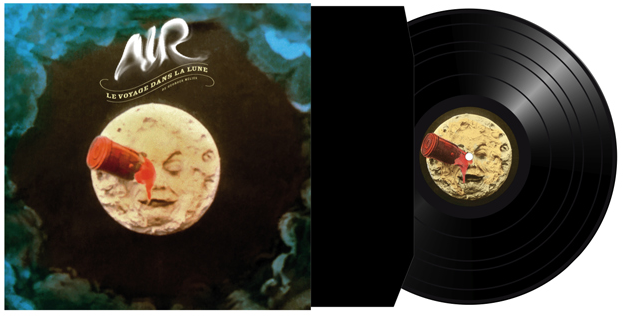 It has been almost 20 years since an original, hand-colored print was discovered of George Méliès’ Le Voyage dans la Lune (A Trip to the Moon). It took more than half that time to repair the film for screening purposes. Part of that time was just waiting for the technology to catch up to the needs required for the destroyed nitrate print. A good place to see the state of disrepair the film was found in can be found at the Technicolor Film Foundation. The restoration was deservedly painstaking. Considered the first science-fiction film in movie history, this 16-minute short from 1902 is one of the most famous of the early silent films. Original hand-colored films in those days were rare, as well. To find one made of one of the most iconic silent films in history, almost a hundred years later, marked a jackpot find.
It has been almost 20 years since an original, hand-colored print was discovered of George Méliès’ Le Voyage dans la Lune (A Trip to the Moon). It took more than half that time to repair the film for screening purposes. Part of that time was just waiting for the technology to catch up to the needs required for the destroyed nitrate print. A good place to see the state of disrepair the film was found in can be found at the Technicolor Film Foundation. The restoration was deservedly painstaking. Considered the first science-fiction film in movie history, this 16-minute short from 1902 is one of the most famous of the early silent films. Original hand-colored films in those days were rare, as well. To find one made of one of the most iconic silent films in history, almost a hundred years later, marked a jackpot find.
Le Voyage dans la Lune‘s rebirth is now being celebrated with special screenings at art houses across the US. It already began visiting big screens in South Florida beginning in Broward County, at the Cinema Paradiso, where it premiered on March 3. It will appear in Miami-Dade, finally, at the Miami Beach Cinematheque, starting March 23, as part of the European Film Festival in Miami 2012. This new restoration had its world premiere at Cannes, last year.
Big for music fans, as this is a silent film, is a new score by France’s most internationally successful contemporary music duos: Air. The union might seem odd, at first, but Nicolas Godin and Jean-Benoit Dunckel have always had a penchant for the retro, even though one might argue that even the most vintage of instruments the duo routinely incorporates could be considered modern compared to the 110-year-old film they have now scored.
The union might seem odd, at first, but Nicolas Godin and Jean-Benoit Dunckel have always had a penchant for the retro, even though one might argue that even the most vintage of instruments the duo routinely incorporates could be considered modern compared to the 110-year-old film they have now scored.
Though the synth-heavy duo do not shy away from modern implements like reverbing electric guitar, sparkling organs and even ominous mellotron, there is also timpani, strings, harpsichord and even a few plucks of a banjo, which may just have well been instruments used at the turn of the 20th century. It’s all on display on this new, dynamic score that they not only fashioned for the film but also jumped off from to create songs inspired by the movie. Air mix it all together for an evocative work as good as anything in their discography.  The soundtrack therefore doubles as the duo’s eighth album since their debut in 1998. Victoria Legrand, the dreamy, hushed voice of Baltimore-based Beach House, takes lead vocals on “Seven Stars.” It’s a funny coincidence that she happens to be a niece of the famed French composer Michel Legrand. His songs appeared in Jacques Demy’s The Umbrellas of Cherbourg, and he won an Oscar® for his work on Yentl.
The soundtrack therefore doubles as the duo’s eighth album since their debut in 1998. Victoria Legrand, the dreamy, hushed voice of Baltimore-based Beach House, takes lead vocals on “Seven Stars.” It’s a funny coincidence that she happens to be a niece of the famed French composer Michel Legrand. His songs appeared in Jacques Demy’s The Umbrellas of Cherbourg, and he won an Oscar® for his work on Yentl.
This new music for Le Voyage dans la Lune fits fine in both Air’s discography, continuing its more accessible sound from their last full-length, Love 2, and to hear it accompanied by the fantastical imagery that inspired it on the big screen is a must for fans of Air. The band remains consistent, proving they know how to handle a score, just as they did with Sophia Coppola’s debut film, the Virgin Suicides.
A vinyl version is due out on April 2, and though available as an import-only, at a steeper price than usual, it should sound worthwhile. Just like Air’s last album, Love 2, it will come on heavy 180 gram vinyl in a gatefold sleeve produced by the boutique vinyl EMI subsidiary the Vinyl Factory. There is also a limited edition box set (only 300 manufactured for worldwide distribution) on higher quality 45 rpm 12-inch records that includes a signed art print by the duo. But all versions of the album include the newly restored color version of Le Voyage dans la Lune on an all-region coded DVD, which also features music exclusive to the score and not featured on the album.
These up-coming theatrical presentations will also feature something exclusive: the documentary film the Extraordinary Voyage by Serge Bromberg and Eric Lang, which spends just over an hour examining the history of this film’s restoration and impact on early impact on cinema.  I have not seen this yet, but, according to Miami Beach Cinematheque’s website, it features interviews with Tom Hanks, Michel Gondry, Jean-Pierre Jeunet and Michel Hazanavicus. It reportedly covers everything from the original film’s 1902 production to the rediscovery of the hand-colored nitrate print in 1993, and the premiere of the restoration on the opening night of the Cannes Film Festival in 2011.
I have not seen this yet, but, according to Miami Beach Cinematheque’s website, it features interviews with Tom Hanks, Michel Gondry, Jean-Pierre Jeunet and Michel Hazanavicus. It reportedly covers everything from the original film’s 1902 production to the rediscovery of the hand-colored nitrate print in 1993, and the premiere of the restoration on the opening night of the Cannes Film Festival in 2011.
But the real treat will be the chance to see the 16-minute short on the big screen. Méliès practically invented the film narrative with this film using complex sets and costumes. He incorporated special effects like stop motion, and even the dissolves between cuts are credited as his invention. There is no arguing that this film deserves care and preservation. Martin Scorsese laid it out passionately in the subtext of his most recent film, Hugo, which featured Méliès as a character (played by Ben Kingsley). For me, the most amazing aspect of Hugo, were the recreations of the famous sets for Le Voyage dans la Lune, and even performances of the scenes, which unfolded in 3-D on the big screen. It was a surreal, mind-blowing delight that I had not expected to see, as the media was so busy hyping the fact that Hugo marked Scorses’s first 3-D family film.
The word “dream factory” was co-opted by Hollywood long after Méliès knew the power of cinema. In Hugo, Méliès tells the young hero of the film, “If you’ve ever wondered where your dreams come from, you look around… this is where they’re made.” On his deathbed, he famously told Henri Langlois and Georges Franju, “Laugh, my friends. Laugh with me, laugh for me, because I dream your dreams.” (Henri Langlois, First Citizen of Cinema, p. 41). If I had to choose between the idealistic Méliès over the corporate machine of Hollywood, I would hand it to Méliès as the true pioneer of the dream machine now well-known as the movie projector.
The newly restored hand-colored version of Le Voyage dans la Lune and The Extraordinary Voyage will screen in high-definition digital projection, Friday night (March 23), at 7 p.m. , at the Miami Beach Cinematheque. It will play every following night through Monday night (March 26th), at 7 p.m. each night. For other screening dates throughout the year, see Air’s official homepage on Astralwerks Records.












Brilliant brilliant what a magnificent achievement.
[…] 9) A Trip to the Moon [1902]/ Setting: year 2002 […]
[…] 9) A Trip to the Moon [1902]/ Setting: year 2002 […]